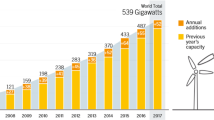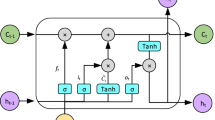Abstract
Wind power generation helps to save energy and reduce emissions. Accurate wind speed prediction can ensure the safe integration of wind power into the energy grid, but due to the intermittent and volatile nature of wind, it brings great difficulties to wind speed prediction. To solve this issue, this paper develops a hybrid forecasting model called WT-VMD-LSTM-TCN, where the wavelet transform (WT) is used to decompose the original wind speed into multiple detailed components and an approximate component, then the variational mode decomposition (VMD) is employed to further decompose the first detailed component, and several intrinsic mode functions and a residual term are obtained. Subsequently, the LSTM-TCN model is established on each component obtained by WT and VMD, where the component is first input into the long short-term memory (LSTM), and then the output sequence of LSTM is input into the temporal convolutional network (TCN) for processing. Ultimately, the predicted results of all components from WT-VMD are reconstructed to obtain the predicted value of wind speed. The performance of the model is verified by simulation experiments with three datasets. The experimental results show that: (a) The developed LSTM-TCN model integrates the feature extraction methods of LSTM and TCN, and the feature extraction ability is more comprehensive, which can improve the forecasting performance of a single model; (b) VMD is used to decompose the subsequence with the largest error, which reduces the difficulty of the prediction of this subsequence; (c) WT-VMD-LSTM-TCN is superior to other comparison models in three datasets, which verifies that the model has good applicability.














Similar content being viewed by others
Data availability
The data that support the findings of this study are available from the corresponding author upon reasonable request.
References
Amjady N, Keynia F (2009) Short-term load forecasting of power systems by combination of wavelet transform and neuro-evolutionary algorithm. Energy (oxf) 34(1):46–57. https://doi.org/10.1016/j.energy.2008.09.020
Astsatryan H, Grigoryan H, Poghosyan A, Abrahamyan R, Asmaryan S, Muradyan V, Tepanosyan G, Guigoz Y, Giuliani G (2021) Air temperature forecasting using artificial neural network for Ararat valley. Earth Sci Inform 14(2):711–722. https://doi.org/10.1007/s12145-021-00583-9
Bai S, Kolter JZ, Koltun V (2018) An Empirical Evaluation of Generic Convolutional and Recurrent Networks for Sequence Modeling. arXiv:1803.01271. https://doi.org/10.48550/arXiv.1803.01271
Catalao J, Pousinho H, Mendes V (2011) Short-term wind power forecasting in Portugal by neural networks and wavelet transform. Renew Energy 36(4):1245–1251. https://doi.org/10.1016/j.renene.2010.09.016
Chen Y, Zhang S, Zhang W, Peng J, Cai Y (2019) Multifactor spatio-temporal correlation model based on a combination of convolutional neural network and long short-term memory neural network for wind speed forecasting. Energy Convers Manag 185:783–799. https://doi.org/10.1016/j.enconman.2019.02.018
Dragomiretskiy K, Zosso D (2014) Variational Mode Decomposition. IEEE Trans Signal Process 62(3):531–544. https://doi.org/10.1109/TSP.2013.2288675
Geng D, Zhang H, Wu H (2020) Short-Term Wind Speed Prediction Based on Principal Component Analysis and LSTM. Appl Sci (basel) 10(13):15. https://doi.org/10.3390/app10134416
Harbola S, Coors V (2019) One dimensional convolutional neural network architectures for wind prediction. Energy Convers Manag 195:70–75. https://doi.org/10.1016/j.enconman.2019.05.007
He Y, Zhao J (2019) Temporal Convolutional Networks for Anomaly Detection in Time Series. J Phys: Conf Ser 1213(4):42050. https://doi.org/10.1088/1742-6596/1213/4/042050
Jaseena KU, Kovoor BC (2020) A hybrid wind speed forecasting model using stacked autoencoder and LSTM. J Renew Sustain Energy 12(2):023302. https://doi.org/10.1063/1.5139689
Jung J, Broadwater RP (2014) Current status and future advances for wind speed and power forecasting. Renew Sustain Energy Rev 31:762–777. https://doi.org/10.1016/j.rser.2013.12.054
Li B, Zhuang XY (2020) Multiscale computation on feedforward neural network and recurrent neural network. Front Struct Civ Eng 14(6):1285–1298. https://doi.org/10.1007/s11709-020-0691-7
Li C, Huang JP, Li ZC, Wang RR (2017) Regularized least-squares migration of simultaneous-source seismic data with adaptive singular spectrum analysis. Pet Sci 14(1):61–74. https://doi.org/10.1007/s12182-016-0134-1
Li MS, Zhang ZY, Ji TY, Wu QH (2020) Ultra-short Term Wind Speed Prediction Using Mathematical Morphology Decomposition and Long Short-term Memory. CSEE J Power Energy Syst 6(4):890–900. https://doi.org/10.17775/CSEEJPES.2019.02070
Li WS, Wei YG, An D, Jiao YS, Wei Q (2022) LSTM-TCN: dissolved oxygen prediction in aquaculture, based on combined model of long short-term memory network and temporal convolutional network. Environ Sci Pollut Res Int 29(26):39545–39556. https://doi.org/10.1007/s11356-022-18914-8
Mallat S (1989) A theory for multiresolution signal decomposition: the wavelet representation. IEEE Trans Pattern Anal Mach Intell 11(7):674–693. https://doi.org/10.1109/34.192463
Mubeen MMS, Priya SM, Vijayaraj M (2022) An effective approach of CNN based hybrid Meta- heuristic optimization classifier for retrieving satellite images. Earth Sci Inform 15(1):253–264. https://doi.org/10.1007/s12145-021-00717-z
Oberlin T, Meignen S, Perrier V (2012) An Alternative Formulation for the Empirical Mode Decomposition. IEEE Trans Signal Process 60(5):2236–2246. https://doi.org/10.1109/TSP.2012.2187202
Pan HY, Yang Y, Li X, Zheng JD, Cheng JS (2019) Symplectic geometry mode decomposition and its application to rotating machinery compound fault diagnosis. Mech Syst Signal Process 114:189–211. https://doi.org/10.1016/j.ymssp.2018.05.019
Qu ZX, Mao WQ, Zhang KQ, Zhang WY, Li ZP (2019) Multi-step wind speed forecasting based on a hybrid decomposition technique and an improved back-propagation neural network. Renew Energy 133:919–929. https://doi.org/10.1016/j.renene.2018.10.043
Seng DW, Lv FS, Liang ZY, Shi XY, Fang QM (2021) Forecasting traffic flows in irregular regions with multi-graph convolutional network and gated recurrent unit. Front Inform Technol Elect Eng 22(9):1179–1193. https://doi.org/10.1631/FITEE.2000243
Shahid F, Zameer A, Muneeb M (2021) A novel genetic LSTM model for wind power forecast. Energy (Oxf) 223:120069. https://doi.org/10.1016/j.energy.2021.120069
Sun W, Wang R (2018) Fully Convolutional Networks for Semantic Segmentation of Very High Resolution Remotely Sensed Images Combined With DSM. IEEE Geosci Remote Sens Lett 15(3):474–478. https://doi.org/10.1109/LGRS.2018.2795531
Talaslioglu T (2019) Optimal design of steel skeletal structures using the enhanced genetic algorithm methodology. Front Struct Civ Eng 13(4):863–889. https://doi.org/10.1007/s11709-019-0523-9
Tong JL, Zhao ZB, Zhang WY (2012) Wind speed forecasting using a combined method based on auto regression and wavelet transform. Advanced Materials Research 512–515:803–808. https://doi.org/10.4028/www.scientific.net/AMR.512-515.803
Wang Y, Zou RM, Liu F, Zhang LJ, Liu QY (2021) A review of wind speed and wind power forecasting with deep neural networks. Appl Energy 304:117766. https://doi.org/10.1016/j.apenergy.2021.117766
Wu QL, Lin HX (2019) Short-Term Wind Speed Forecasting Based on Hybrid Variational Mode Decomposition and Least Squares Support Vector Machine Optimized by Bat Algorithm Model. Sustainability 11(3):652. https://doi.org/10.3390/su11030652
Xiahou SJ, Liang YH, Ma M, Du MR (2022) A strong anti-noise segmentation algorithm based on variational mode decomposition and multi-wavelet for wearable heart sound acquisition system. Rev Sci Instrum 93(5):054102. https://doi.org/10.1063/5.0071316
Xu YY, Yang GK (2020) A Short-Term Wind Speed Forecasting Hybrid Model Based on Empirical Mode Decomposition and Multiple Kernel Learning. Complexity 2020:1–3. https://doi.org/10.1155/2020/8811407
Yang JX (2019) A novel short-term multi-input-multi-output prediction model of wind speed and wind power with LSSVM based on improved ant colony algorithm optimization. Cluster Comput 22(2):S3293–S3300. https://doi.org/10.1007/s10586-018-2107-1
Yang RX, Xiong R, Shen WX, Lin XF (2021) Extreme Learning Machine-Based Thermal Model for Lithium-Ion Batteries of Electric Vehicles under External Short Circuit. Engineering 7(3):395–405. https://doi.org/10.1016/j.eng.2020.08.015
Yildiz C, Acikgoz H, Korkmaz D, Budak U (2021) An improved residual-based convolutional neural network for very short-term wind power forecasting. Energy Convers Manag 228:113731. https://doi.org/10.1016/j.enconman.2020.113731
Yu YX, Han XS, Yang M, Yang JJ (2020) Probabilistic Prediction of Regional Wind Power Based on Spatiotemporal Quantile Regression. IEEE Trans Ind Appl 56(6):6117–6127. https://doi.org/10.1109/TIA.2020.2992945
Zhang MJ, Xu FY (2019) Variational mode decomposition based modal parameter identification in civil engineering. Front Struct Civ Eng 13(5):1082–1094. https://doi.org/10.1007/s11709-019-0537-3
Zhang D, Peng XG, Pan KD, Liu Y (2019) A novel wind speed forecasting based on hybrid decomposition and online sequential outlier robust extreme learning machine. Energy Convers Manag 180:338–357. https://doi.org/10.1016/j.enconman.2018.10.089
Zhang Y, Xiao LX, Zhou H, Zhao GH (2022) Control strategy of wind power smooth grid connection based on adaptive VMD and hybrid energy storage. J Renew Sustain Energy 14(2):023306. https://doi.org/10.1063/5.0077754
Zhao Y, Jia L (2020) A New Hybrid Forecasting Architecture of Wind Power Based on A Newly Developed Temporal Convolutional Networks. 2020 IEEE 9th Data Driven Control and Learning Systems Conference (DDCLS):839–844. https://doi.org/10.1109/DDCLS49620.2020.9275243
Zhou QG, Wang C, Zhang GF (2020) A combined forecasting system based on modified multi-objective optimization and sub-model selection strategy for short-term wind speed. Appl Soft Comput 94:106463. https://doi.org/10.1016/j.asoc.2020.106463
Zhu HC, Wei FR, Qin B, Liu T (2018) Hierarchical Attention Flow for Multiple-Choice Reading Comprehension. Proc AAAI Conf Artif Intell 32(1):6077–6084. https://doi.org/10.1609/aaai.v32i1.12040
Acknowledgements
We want to thank all participants of the article. We thank the reviewers and editors for their constructive feedback regarding the initial version of the manuscript.
Funding
This research work is funded by the National Natural Science Foundation of China (No. 41875085).
Author information
Authors and Affiliations
Contributions
Keke Ma built the model and wrote the manuscript, Jing Zhao proposed innovations and guided the experiments and thesis, Wenyu Zhang and Zhenhai Guo collected observational data, Wenzhi Qiu programmed and programmed the experiments. All authors reviewed the paper.
Corresponding author
Ethics declarations
Competing interests
The authors declare no competing interests.
Consent for publication
All authors approved the final manuscript and the submission to this journal.
Conflict of interest
The authors have no conflicts to disclose.
Additional information
Communicated by H. Babaie.
Publisher's note
Springer Nature remains neutral with regard to jurisdictional claims in published maps and institutional affiliations.
Rights and permissions
Springer Nature or its licensor (e.g. a society or other partner) holds exclusive rights to this article under a publishing agreement with the author(s) or other rightsholder(s); author self-archiving of the accepted manuscript version of this article is solely governed by the terms of such publishing agreement and applicable law.
About this article
Cite this article
Ma, K., Zhang, W., Guo, Z. et al. A hybrid forecasting model for very short-term wind speed prediction based on secondary decomposition and deep learning algorithms. Earth Sci Inform 16, 2421–2438 (2023). https://doi.org/10.1007/s12145-023-01044-1
Received:
Accepted:
Published:
Issue Date:
DOI: https://doi.org/10.1007/s12145-023-01044-1




